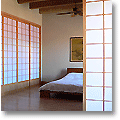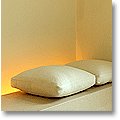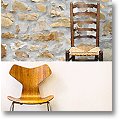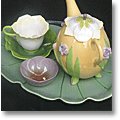Zen Bedroom Design & Decorating Ideas
A Zen bedroom doesn't need to look Japanese. Why?
♦ Here's the short explanation,
♦ and here's a more comprehensive one.
Traditional Japanese bedroom design, of course, has a 'built-in' Zen aesthetic, and many Western interior designers have experimented with the tatami look. (Check out some photos of Asian inspired bedrooms here; more about the basics of Zen Interior Design here.)
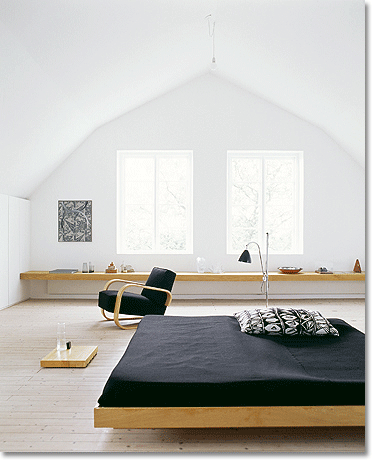
Zen bedroom in southern Sweden. © Janne Peters
So what makes a bedroom 'Zen'?
A Zen bedroom
♦ contains only essential furniture;
♦ is clutter free;
♦ is low on pattern and decorative detail;
♦ uses a minimum of wall art;
♦ is furnished with natural, attractive materials;
♦ has built-in, 'hidden' storage rather than free-standing furniture elements.
The opposite of a Zen bedroom ....
♦ is a room with stuff lying around everywhere
(clothes, books, gadgets, throw pillows);
♦ full of color and pattern;
♦ with ruffled or glossy fabrics;
♦ patterned area rugs / wallpaper;
♦ elaborate picture frames / mirrors;
♦ opulent window treatments.
Zen Style Bedroom Examples
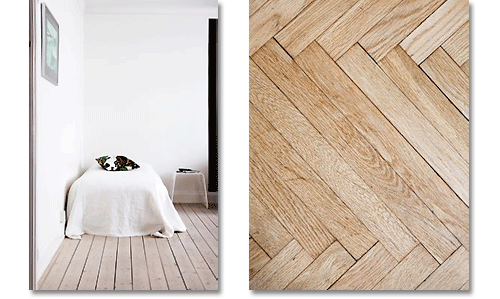
Zen style bedroom with bleached oak flooring, Stockholm (Sweden). © bolaget)
For a truly monastic look, this sparse Swedish bedroom would do perfectly! However, you can add more comfort and still have a Zen bedroom.
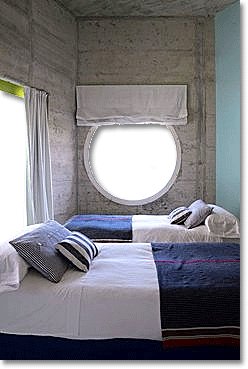
Nautical 'Zen style' bedroom in France.
© Albert Font for côté sud)
For example, the 'nautical' blue, gray & white bedroom to the left embodies the Zen aesthetic beautifully, even with two (gasp!) patterned cushions per bed.
3 'Zen tricks' were used in this room:
♦ Reduce the color palette to neutrals + one calm, cool color.
♦ Create large, solid 'color fields' with straight edges (e.g. plain white bedlinen & pattern-free bed coverlets).
♦ Keep the window treatments simple and in solid colors (no patterns).
Zen Style Bedrooms: Rustic Or Polished?
It's entirely up to you. Apart from an obvious 'tech' look with lots of glass and shiny metal surfaces (which would offend a Zen practitioner's reverence for nature), there's a lot of scope between the extremes of this ...
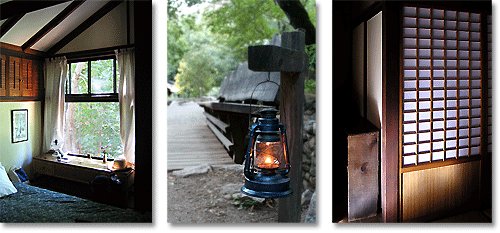
Zen monastery & retreat center, Tassajara Springs, California (USA).
© Earthw. (left); Brett (center); N. Yoder (right)
... and this:
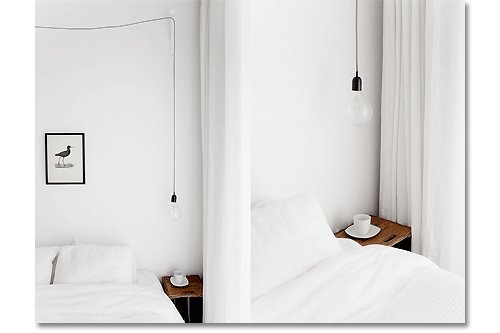
All-white Skandinavian Zen style bedroom. © Jakob Nylund
For comparison, have a look at the interesting Japanese-Swedish 'hybrid' Zen style bedroom below. It has - for Japan - uncharacteristic white walls and borderless tatami mats. However, it's the most Japanese-looking bedroom on this page:
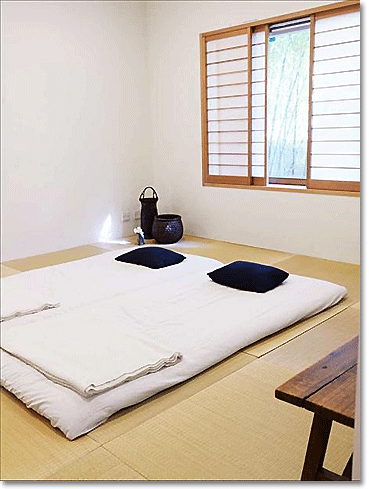
Bedroom of a Japanese/Swedish family in Tokyo.
© Lena Granefelt for sköna hem
Zen Bedroom Design: How Much Pattern?
When it comes to pattern in a Zen bedroom, less is more, and smaller is better. Compare these two bedrooms:
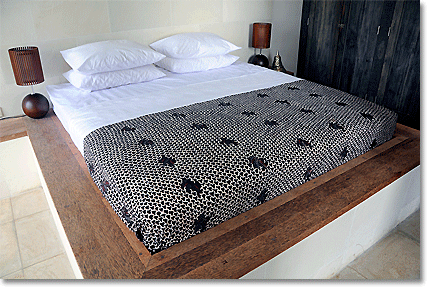
Cool, calm 'Zen' style bedroom in Bali, Indonesia. © Bart Speelman
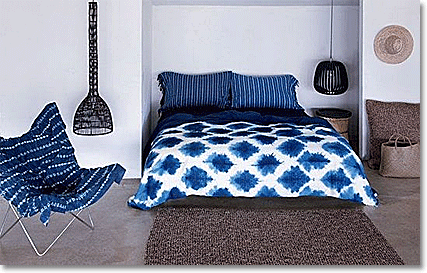
Bedroom with indigo-dyed fabrics from Japan & France.
© Mark Eden Schooley for côté sud
Both rooms have very similar blue-white-brown color schemes. However, the scale of the pattern in the second photo draws much more attention to the bed spread and has way more impact on the entire look & feel of the room..
Is one of these two not a Zen bedroom? Well, that's your shout. If you find the large pattern too distracting, then the second room isn't. If you think the simple, natural furnishings and overall spare look make up for the loud, striking bedspread, then it is a Zen room ;-)
A Word About Zen
Zen is a Buddhist meditation practice. Zen teachings don't actually address any interior design or decorating issues, but they do emphasize a rigorously simple and disciplined lifestyle.
In the West, however, the word "Zen" has come to mean a number of different things, for example:
♦ "Japanese", or
♦ "Japanese looking", or
♦ "minimalist with an Asian twist", or
♦ "simple, sparse and meditative".
Strictly speaking, there's no such thing as a Zen bedroom, because the 'bedroom' of a Zen monastic is their tatami mat in the zendo (= meditation hall), where they sleep at night and sit in meditation for much of the day.
So when you hear me talk about 'Zen bedroom design', just be aware that the concept of a 'Zen bedroom' is created, it's not historical. We're making it up as we go along :-)
Related Pages (Click A Pic):
Zen Decorating Bookshop
If you would like to add a traditional Japanese touch to your home, check out this mini bookshop (in partnership with Amazon):
For not-necessarily-Asian-inspired Zen bedroom designs, try a book or two from this collection:
- The basics of Zen design
- How to get the Zen look without 'going Asian' on your home.
- If, instead, you want a typical Japanese look, start from the bottom up: with tatami floor mats.
- Create a 'Zen bedroom', just by losing stuff:
How To Organize Clutter
- Using Color In Zen Interiors:
Neutral Color Schemes - The Book:
Neutral color palettes are a perfect fit for Zen decorating, but they're not as straightforward as many people think. Understand what makes neutral color schemes look their best, and what happens when you mix neutral color palettes with more saturate decorating colors. It's FREE!! -
Understand Interior Design Styles:
a) Interior Design Styles List
b) Interior Decorating: Style vs. Fashion

